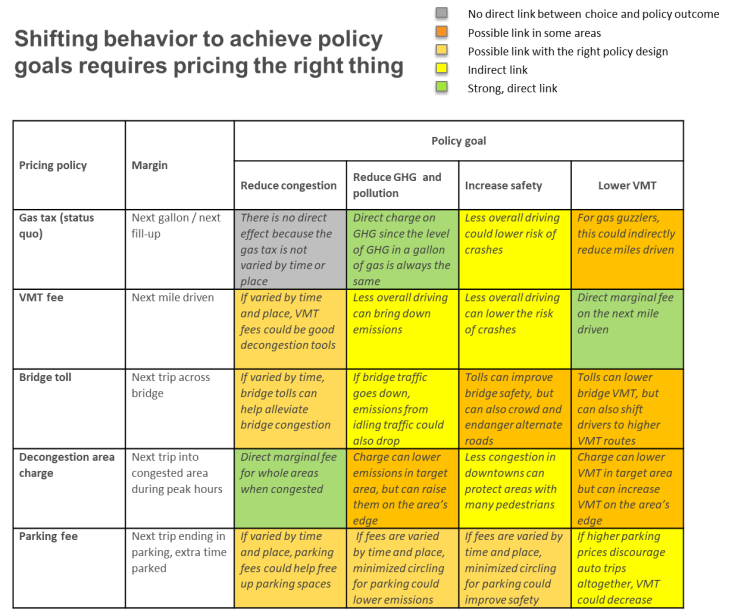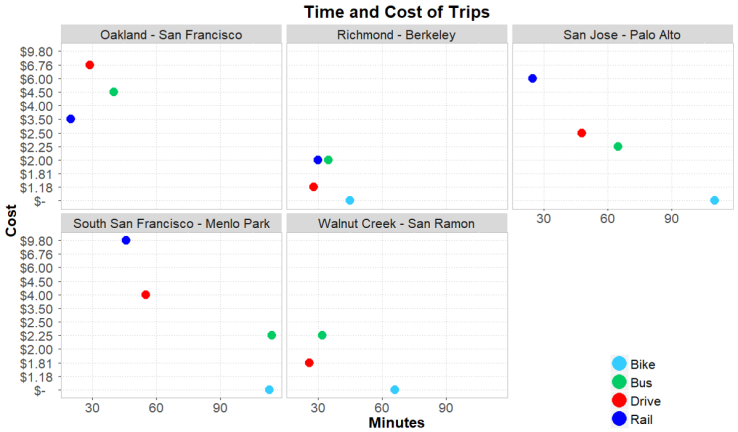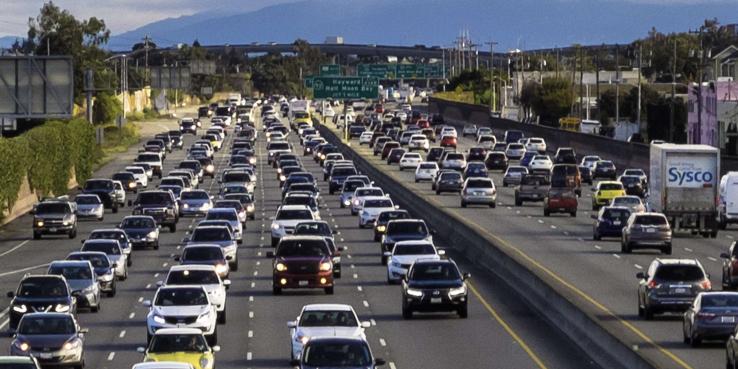There’s been a lot of interest in recent years in putting new prices on driving: California legislators proposed a bill that would have allowed pricing pilots to limit congestion in big cities, cities have called to add fees to Uber and Lyft rides, California and Oregon piloted vehicle fees based on mileage, Vancouver is moving forward with its decongestion charging scheme and more.
All of these policies have one thing in common: they discourage driving by asking drivers to pay a share of the costs it imposes on others. Yes, the driving we do has costs for others: It puts emissions in the air, which others pay for by breathing poorer quality air and getting sick more often, the space our car takes up on the road costs others time in traffic, and so on. Road pricing doesn’t collect money to pay for these problems, instead it simply reminds drivers that their driving is costly. This price discourages driving and limits the widespread problems it causes. Admittedly, asking people to pay for something that has been free for so long can be practically and politically unpopular, but transportation pricing is one of the most effective tools we have for limiting congestion, pollution, heart and respiratory disease, greenhouse gases (GHG) and injuries and deaths from collisions.
While these new efforts are similar in that they put a price on driving, they are also different in meaningful ways. Some would charge all drivers for entering a congested area, some would just charge Uber and Lyft drivers, and some would charge a VMT (vehicle miles traveled) fee for every mile driven. The nudges these different prices give us are distinct, and each would shift us into different travel patterns. When our city and state governments do finally enact transportation pricing policies, it will be important that they understand these differences and get clear about what each type of policy is designed to do best. Otherwise we will witness the backlash that comes when new road pricing does not bring with it the benefits of targeted congestion relief, safer streets and cleaner air.
Understanding transportation pricing design features — what’s best to price where and when and how — takes careful consideration. This is especially true in the Bay Area, a region fragmented by nine counties and congestion management districts, 101 cities, 27 transit agencies, a large bay and a crisscrossing network of roads under alternating federal, state and local control. But it’s worth figuring out. After all, road pricing gets one of highest cost-benefit scores of the regional transportation measures out there, and right now we’re leaving those benefits — shorter commuters, less pollution and safe roads and crosswalks — on the table.
After reviewing years of literature on transportation pricing policies around the world, SPUR offers six key principles for a well-functioning, equitable transportation future where we all face the true costs of our travel. These principles offer an economic framework on how policy nudges are likely to affect travel behavior. That way, when policymakers enact transportation pricing, they’ll be prepared with options and their tradeoffs — and we will all be poised to enjoy their benefits.
Six Key Principles for Effective and Fair Transportation Pricing
1. Set goals and price the right thing to achieve them.
Economists use the term “margin” to refer to moments where small, incremental changes occur. These can include changes in the choices we make. Regarding travel choices, a margin occurs where you’re about to take one more trip, drive one more mile, or fill your gas tank up one more time. While these daily moments are often invisible, they are points where the power of other small changes — such as an increase in the cost of gas or a transit fare — can come in to shift those individual choices and collective behavior.
For example, the tax on gas makes it a bit less appealing to put an extra gallon in the tank. A fee on the number of miles driven makes drivers think twice about taking the scenic route, because those extra miles of road cost more. A policy that charges drivers to enter a city when and where it’s most congested makes drivers consider a trip during rush hour more carefully.
There’s one last important margin, and it’s the one where small changes in the social costs of driving occur – where exhaust from driving makes the air just bad enough to send one more child with asthma to the emergency room, or where that one extra car on the busy highway tips everyone into traffic gridlock.
Transportation pricing is most powerful when the price serves as a direct link between an individual’s incremental choice and the incremental damage that choice costs society.
Just as you wouldn’t apply sunscreen for allergies or take Claritin for sun protection, matching appropriate problems to solutions is just as critical in transportation pricing. The table below shows where a transportation fee directly links everyday choices with the broad issues policymakers aim to solve, such as reducing congestion and emissions and or improving safety.

In the table above, there are only three green boxes where simply putting a price on something creates a direct link between individuals’ choices and results toward achieving a policy goal. The yellow boxes. indicate where a price is likely to help move toward a policy goal indirectly. The dark orange boxes indicate where the benefits of a new price may be different in different places or for different types of cars or drivers. The light orange boxes indicate where achieving the policy goal depends greatly on various design options within a transportation pricing policy. For example, if designed properly, a VMT fee could be varied by place and time of day to double as an effective decongestion charge. The vast amount of orange tells a simple but often overlooked story: the design of pricing policy matters. While there is no magic pricing policy that can solve all of our problems, policies like VMT charging, which can be adjusted to meet different policy goals in different times and places, are best poised to bring about the widest array of benefits. There are multiple potential legislative and political hurdles to clear to enact pricing policies in our region. If as a society, we don’t have a strong vision of our collective goals and an understanding of how to effectively achieve them, we are very unlikely to have anything but the congested, polluted status quo.
Missing from the table is revenue. Many parking fees, bridge tolls and registration fees on cars are designed to raise revenue instead of shift behavior, a necessary goal to fund transit, roads and other transportation projects. While they’re not explicitly about changing behavior, revenues from transportation fees can be invested to make transit, biking or carpooling faster, safer and/or cheaper than driving alone.
2. Make the prices optimal.
It’s also important to charge the right price. Like matching policy goals to shifts in behavior, the right price is a match-making exercise. For example, the decongestion charge we pay as drivers should equal the value of the extra time we cost ourselves and everyone else stuck in traffic. (For those of you who like word problems, if extra cars are slowing everyone down by 10 minutes and we all value our time at $0.50 per minute, then the decongestion charge per car in a congested area should be $0.50 per minute x 10 minutes, or $5.) Charging the optimal price means knowing the maximum threshold of traffic drivers are willing to accept and charging for anything above it at the best known price for people’s time. This means that policymakers don’t charge so much that no one can afford to drive — and don’t charge so little that drivers simply pay to continue to sit in traffic.
3. Make good travel behavior easy to understand.
If the goal is to shift behavior and reduce some of the ills of traffic and pollution, the price signal has to be obvious. A VMT fee that comes as a bill in the mail once a year is really just a bill. But a ticker in a car that tallies up a small fee at the end of each trip would give drivers real-time feedback about how much they’ve just driven and what it cost them. It will help tell people which routes are shorter, or how well they’ve done to bundle trips in an errand run. Many hybrid cars already have a function like this that tells drivers how their driving is affecting their gas mileage in each moment. This kind of real-time feedback and real-time charging is important to coaching drivers into better habits. If prices for VMT also vary by how congested the roads are, drivers could have the option of checking a website or app to see the real-time VMT fee and avoid adding to congestion if they change their route or make the trip later. Everyone who travels in the region is better off if it’s clear what the real-time conditions are and how individual travel choices contribute to or help solve collective problems.
4. Do pilots to test and prove benefits.
Starting with pilots can help make the hard-to-imagine benefits of decongestion charges more real, especially for people who might otherwise oppose new road prices. The cities of London and Stockholm ran decongestion pricing pilots before citizens voted them in to stay, while in Edinburgh, such a policy never made it off the ground because voters shut it down before it was ever tested or its benefits felt.
5. Make sure the relative prices are right.
In urban areas, people have choices about how to get where they go. In many parts of the Bay Area they can drive, bike, take transit or use a combination of these travel modes. This choice depends on how long each option will take, their relative comfort, convenience and safety, the per-trip cost and more. If driving becomes more expensive per trip, that can be enough to get some people out of their cars and into carpools or other travel modes.
In a small sampling of Bay Area commute trips, plotted below, a trip from Oakland to San Francisco’s job hub is the only one where driving is currently more expensive and takes longer than a transit alternative. (In the first box below, the red dot is higher and further to the right than the dark blue one.) For a variety of reasons — including the relative cost of getting to work — commuters within and into San Francisco County are almost twice as likely to get to work without driving alone compared to other Bay Area counties.
For other corridors where there are both high-quality transit and driving options, charging a fee for driving alone might be the best way to get people out of their cars and onto the suddenly cheaper train or bus.

For different trips, travelers all face different time and dollar costs for using different travel modes. People are nudged to drive alone when it’s quicker and cheaper than taking the train, the bus or biking.
Sources and notes: Cost to drive based on 24 mpg car and $3.40 gallon of gas, includes non-carpool lane bridge tolls but not parking costs. All times estimated using the average of the range given on Google Maps, assuming arrival of 9 a.m. on a weekday morning. Fares on bus and rail assume Clipper fares when there’s a difference between cash and Clipper.
6. Ensure equity by structuring prices progressively or giving revenue back as a dividend.
There are different types of equity to consider in new pricing policies: income, community and modal.
To reach policy goals, every driver needs to see that driving has hidden costs and needs to be charged to help them shift their behavior. However, the simple fact is that when policymakers charge a flat fee for something, those with lower incomes pay a higher percentage of their income on it. This income inequity can and should be addressed. Policies can be designed to charge people of different incomes different fees, which is already done for things like electricity. (Low-income PG&E customers are charged lower rates to keep the lights on.) If prices cannot be varied by income, policymakers can create a dividend – using some revenues to give every driver a flat rebate through a check in the mail or cash on their Clipper card. The flat dividend will benefit people with low incomes the most, making the policy less regressive. The California Climate Credit that utilities give to electricity consumers as part of the state’s cap-and-trade program is a working example of such a dividend.
Revenues can also be used to fund services that people with low incomes use more. The cap-and-trade dollars spent in disadvantaged communities is an example: Combined with the California Climate Credit, it has led to higher benefits than costs to people with low incomes in California.
It’s also worth noting that road pricing can save low-income workers money. Think for example of a single parent rushing from work to pick up a child from day care before being hit with a late pick-up fee. The option to pay for a fast lane on the freeway would likely be lower than the late pick-up fee. This is at least what researchers found in their evaluation of who opted into Southern California HOT lanes.
Another consideration is geographic equity. Pricing policies that lower emissions in historically polluted, disadvantaged communities would be a much-needed relief. Neighborhoods near freeways, where many drivers idle in line to get on or off the freeway, are often low-income neighborhoods and/or communities of color. Clearing the congestion and emissions in these neighborhoods is the right thing to do. In addition, if a pricing policy re-routes more traffic and exhaust into such neighborhoods, this is a step in the wrong direction. Using circulation models that can incorporate these patterns can help avoid policies that simply divert traffic, injuries and emissions instead of truly addressing them.
Lastly, there is modal equity. In London’s decongestion pricing policy, researchers found that bus and tube crowding increased with the new charge, slowing down commutes for those who’d already been taking transit. It’s important to invest revenues to speed up and improve service to make sure that long-time transit riders don’t have slower commutes because of road pricing policies.
Conclusion
In the end, Bay Area residents, workers and policymakers have a lot of choices to make about the future we want to create and how transportation pricing policies can be tailored to help us get there. There’s a lot to weigh and a lot of experimentation to do in order to get it right and keep it working in a society with evolving needs. But doing nothing — letting people get sick from exhaust and letting billions of dollars of human talent while away in traffic — is not the solution. We can build a brighter future, and part of the path to it is getting the prices right.
